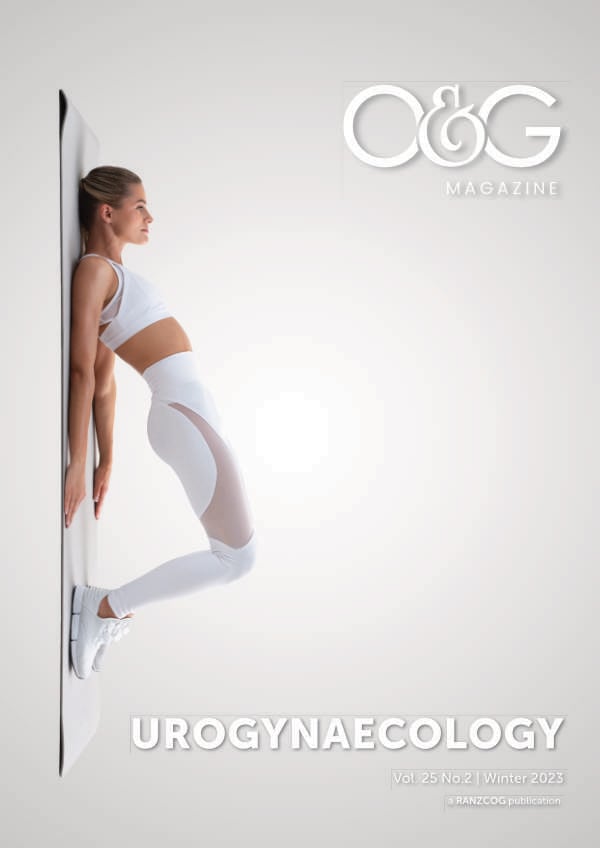Through my own personal experience and as a cofounder and CEO of the Australasian Birth Trauma Association, I have seen and continue to see the devastating consequences that birth injuries have on the lives of those impacted.
In 2015, at 16 months postpartum, I received a diagnosis that altered the course of my life. I had been experiencing symptoms of prolapse (although I didn’t know it then), I went to see a pelvic health physiotherapist and through palpation, she diagnosed me with a bilateral levator avulsion. My pelvic floor muscle was torn off the bone, likely due to the forceps delivery of my daughter. The next most devastating part of that diagnosis was being told that surgery isn’t viable and that I should modify my lifestyle to avoid making things worse. I walked into that appointment one woman and left a completely different person. I lost my sense of identity, I felt broken and alone. I used to wish I had lost a limb because then people would see my suffering.
This is the problem with birth injuries, because you can’t see them, no one knows how much you’re suffering. Unfortunately, once women leave the hospital, there are no clear care pathways for them to follow, even if injuries are identified at the time of birth.
I wanted to be sure of my diagnosis, my physiotherapist mentioned that a urogynaecologist would be able to do a 3D/4D ultrasound; however, seeing my distress, she encouraged me to hold off because the treatment plan would likely remain the same. Instead, she connected me with other women who were further along in their own journeys of navigating early parenthood with birth injuries. Speaking to another person that understood how I felt made a difference. Whilst it didn’t change my situation, it gave me a sense of hope for the future and helped me make sense of my situation.
As professionals working with birthing women, you will see varying degrees of distress, and how you respond to this distress is so important. Everyday we hear stories from women who have sought support for the symptoms, and their concerns are dismissed as ‘normal’ or ‘to be expected after having a baby’. What I need you to know is that their ‘new normal’ may still cause significant impacts on their quality of life. This was a striking feature of the narrative responses in our 2022 Birth Injuries report, how common it was for women to be dismissed or not believed when they reached out for help. Women report feeling confused, dismissed, anxious, neglected, disappointed, unimportant, in limbo and let down by multiple failures to be helped.
It is difficult to have good mental health when you are navigating life with ongoing physical symptom such as pain, incontinence or pelvic organ prolapse. Nine out of 10 women in our report indicated that their injuries impacted their mental health. While women reported experiencing postnatal depression and anxiety, many were experiencing symptoms of Post-Traumatic Stress Disorder. We need clinicians to understand when they meet an individual, they are not just a diagnosis but a real person with possible trauma. It is common for parents that have experienced birth-related trauma to lose trust in the medical profession; some will delay vital treatment to avoid returning to the hospital.
We must strive to improve the quality of care provided to women with birth injuries and create a safe and supportive environment where they can share their experiences and seek help without feeling dismissed or unheard. You can read the full report here, and I encourage everyone to do so to gain a better understanding of the issue. You don’t have to know all the answers to the questions, but you do need to know where to send them for support.
I reached out to members of the ABTA community to ask for experiences with urogynecologists. My hope is that we can learn from these stories.
Interactions with urogynaecologists: consumer perspectives
Tara Aguayo
My first experience with a Urogynecologist was at five months postpartum after being referred by my physio. I prepared a list of questions and counted the days to my appointment in hopes of finally getting some clarity. My husband and I waited over an hour for our appointment, desperately trying to keep our unsettled baby calm, breastfeeding in the waiting room for what felt like eternity.
The visibly flustered and irritated doctor called us in and immediately asked about the details of the birth. Still wrapping my head around the day I nearly lost my life and was left with life-altering injuries, I answered their questions. Tears emerged as the appointment shifted to a disproportionate focus on my appraisal of the birth. With a cold demeanour, I was told that my level of distress about my injuries was ‘not normal’ and that I was ‘depressed’. I felt flushed with humiliation and rage, and it was clear that these doctors had never put themselves in the shoes of their patients. I wondered if perhaps they were inherently defensive as their decisions and use of instruments as an obstetrician were likely causing the same outcomes for other women. The doctor examined me in a rushed manner, abruptly told me that I was there ‘too early’, and told me to come back in a year or two. Perplexed, as their office knew how far postpartum I was, I left with very few of my questions answered and feeling remarkably worse than when I arrived.
I visited four more urogynecologists over the following two years. All but one displayed varying degrees of indifference, inattentiveness, and a lack of empathy. Learning to hide my emotions, I mentally prepared myself each time for care which I knew would be lacking at best. I wondered how so many of these Urogynecologists could be so dismissive to such vulnerable patients, many of whom were there after experiencing birth-related trauma. Support groups revealed my experience was not unique. I could only chalk it up to burnout and protecting their time; if a woman is distressed and they display empathy, it could invite further conversation. But is that all it takes to justify such poor bedside manner?
Perhaps the most disappointing part of my experience was the inconsistency in diagnosis, opinions about my extent of avulsion and whether or not they felt it mattered. Four of the five Urogynecologists waved their hands at any mention of avulsion and told me it makes no difference to their surgical approach, suggesting it doesn’t matter. If research shows that avulsion is the biggest contributing factor in re-prolapsing/surgical failure, then why isn’t it addressed and considered? After a 3D pelvic ultrasound with a fifth urogynecologist, they explained that due to my complete right avulsion, and partial left, my chances of prolapse recurrence after surgery sits somewhere between 60c70%. As there are currently no surgical options to repair avulsion, it wouldn’t be statistically favourable to pursue surgery.
Not only was this news gutting, it reinforced my lack of trust in urogynecologists. Some said I had no avulsion despite being able to palpate it easily, others said unilateral or bilateral. After investing countless hours researching and thousands of dollars over the last two years, I’ve learned that statistically, the first prolapse surgery is the most successful and failure rates skyrocket for subsequent repairs. My priority is to find a Urogynecologist who agrees that 60–70% failure rates are not acceptable, particularly for young women in their thirties such as myself. I hope to find a Urogynecologist who sees beyond the pathological condition of prolapse and acknowledges the psychological and relational effects on their patients, keeping that understanding at the forefront of their interactions and the care they provide. I hope to find a Urogynecologist who has not become swallowed by burnout, rather rejects this broken, band-aid fix that has been offered to women as being the only solution and uses their education and experience to contribute to research, innovating and creating a long-term surgical solution for avulsion.
Lyn Leger
I found my urogynecologist through a referral from my women’s health physiotherapist. During the physical examination by the physiotherapist, she identified likely avulsion of the levator ani muscle and explained that diagnosis was important for management and future treatment options. I followed her advice and made an appointment with the urogynecologist for imaging.
Even before I arrived at the urogynecologist, I was struggling mentally and emotionally and could feel myself spiraling down into darkness. I did not know anyone with my injury, and my experience with some other medical and allied health providers at that point was that they didn’t acknowledge or understand levator avulsion or how this impacted my life in so many ways (physically, being able to parent, my career, my sexual relationship, etc). I had two experiences with practitioners who told me, ‘stop catastrophising’ and ‘this isn’t terminal’. So I was feeling very anxious before my appointment.
On arrival and meeting the urogynecologist, I immediately felt at ease. She was welcoming, kind and empathetic, and asked me lots of questions about what had happened during the birth to cause
the injury, what types of practitioners I had seen, what my understanding was so far of my injury and how I was managing to date. I was crying through much of this as it was extremely traumatic to relive and talk about. She listened and was genuine in all her responses. She explained everything to me, including the nature of the likely diagnosis, the statistics for the injury and prolapse, and various management options.
She then asked me if I was okay to have a physical examination, and when I said yes, she conducted the exam and imaging. Each step of the way, she stopped to explain to me what she was doing, what information this provided her and why it was important to her understanding of my injury. She showed me the images of the avulsion on the screen and pointed out that it showed full avulsion on the right and partial avulsion on the left. I was so devastated to see this on the screen, but at the same time, it was a relief to have someone so clearly show and explain to me what I had been experiencing. She then sat me down and explained everything again based on confirmation of avulsion, and she demonstrated that she understood this was a lifechanging injury. She answered every single one of my questions, and she never made me feel stupid for asking questions, she took the time to make sure I was comfortable with every single answer she gave. Importantly, she understood that you can’t ask questions about something you don’t know anything about i.e. you don’t know what you don’t know. She gave relevant information without being asked. She took the time to explain in detail my management options and, due to my age, recommended ‘conservative management’ (pessary and physio). Based on all her explanations and information provided about the risks of each option, I was comfortable with her recommendations.
Following the appointment, she followed up with my GP to make sure she fully understood the diagnosis so that my Care Plan could be put together appropriately with the right allied health professionals involved.
I still see this urogynecologist annually for checkups and ongoing management. She is still just as kind and empathetic as at that first appointment. At each appointment, she gives information freely and updates me on the latest research around avulsion and possibly surgeries (which is sadly lacking). I strongly believe that if I didn’t find this urogynecologist, who was kind and empathetic and took the time to explain everything in detail, I would not be here today.





Leave a Reply